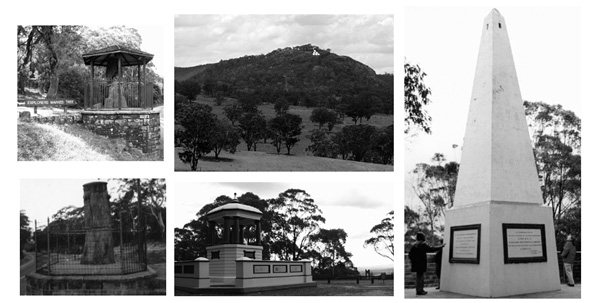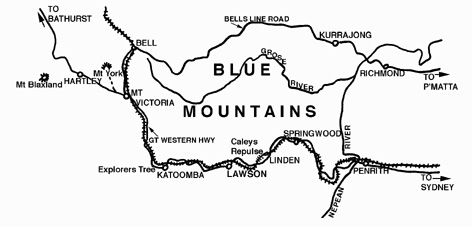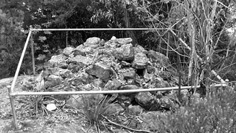
Sites and Monuments shown above are: The Explorers' Tree, Mt Blaxland, Mt York

From 1999 to 2004 Siobhán Lavelle completed a PhD on the Explorers of the Blue Mountains area and the monuments built to commemorate Blue Mountains Exploration. Comments on the thesis by the examiners include:
"Research is thorough, the writing is clear, the analysis probing, and the argument pointed."
"a valuable piece of deconstructionist historical writing"


The Blue Mountains, west of Sydney, NSW, have been celebrated nationally as the locale of the pioneering 'First Crossing' by the three explorers Gregory Blaxland, William Charles Wentworth and William Lawson in 1813. The area contains several long recognised heritage sites, about a dozen in all, ranging from single monuments such as simple rock cairns, to more complex sites thickly populated with elaborate landmark structures and explanatory plaques. Sites such as the Explorers' Marked Tree near Katoomba, or Mount York on the western side of the escarpment, have been valued for their presumed links to an heroic past, peopled with noble explorers and visionary statesmen, yet in many respects this would appear to be the brave and bold pioneering days of the imagination, with appearance and assumption being elevated over actuality. The role of these sites, the events and their place in national history has fuelled debate about their origins and attributions for more than a century.

Major sites in the Blue Mountains include Caley's Repulse, the Explorers' Tree near Katoomba, and Mount York. Other sites and monuments are Mount Blaxland, the Explorers' Lamp at Lawson, the camp site cairn at Glenbrook and the Explorers' Monument at Penrith. These sites are valued as the product of dominant narratives that remain remarkable for their endurance and persistence. The sites are all associated with explorers or explorer myths. The sites are associated with 'original' events or reputed happenings, and with later commemorations and celebrations.
The essential facts of the 1813 event are well known. The three explorers were Gregory Blaxland; Lieutenant William Lawson; and William Charles Wentworth. The party of the three explorers left Blaxland's Farm at South Creek on 11th May 1813 and crossed the Nepean River the same day, camping at the foot of the Mountains. They followed the main ridge which heads west and then north, now the route of the Great Western Highway between Glenbrook and Mount Victoria and reached Mount York on 28th May 1813. They descended into the Kanimbla (Hartley) Valley and climbed Mount Blaxland on May 31st. They returned home by retracing the outward journey, arriving back on 6th June.


Of particular relevance to the theme of re-making the past, was the intense effort made in the early twentieth century to locate sites and relics of the Explorers and Road-builders and to mark and express the cultural value they embodied. The Blue Mountains Centenary Celebrations Committee was formed in July 1912 by a group of local Blue Mountains and Sydney businessmen and prominent citizens. They hunted for surviving sites and relics of exploration, organised the erection of plaques and monuments, and prepared a day of official festivities attended by the NSW Governor and other dignitaries at Mount York on 28 May 1913. The Centenary Committee also published a book compiled by Frank Walker, the "Official History of the First Crossing of the Blue Mountains in 1813".
The
1913 anniversary commemorations in the Blue Mountains partly built upon
the prior celebrations of 1888 as the centenary of white 'settlement'
of NSW, and were a significant forerunner to the sesquicentenary
celebrations of 1938.



The present day sites associated with explorers in the Blue Mountains
illustrate issues about how history is made and how beliefs become
enshrined in public consciousness. The histories of these individual
sites suggest that this conciousness may exist concurrently at various
levels: local/regional and state/national. The Blue Mountains sites
provide evidence of shifting cultural changes, about historical
conceptions, about the making of history and the allocation of
significance to particular places and about memorialisation and
celebration. They also indicate how perceptions of these matters alter
through time.
There are important implications in the selection and uses of sites or monuments and the role and importance of retaining physical sites (or relics) as historical prompts. Sustaining myths were developed to exclude others and subsequently 'underwritten' by a physical heritage. Monuments are clearly about legitimising a claim, and they provide proof by physical entity. Monuments also diminish the anxiety about memory left to its own unseen devices and serve to anchor collective remembering in highly condensed, fixed and tangible sites.
In engaging with these sites and monuments there is an opportunity to also examine and engage with the creative processes of historic and heritage myth-making. In this respect context becomes critical as the past is constantly re-cast and remade in the image of the historic present. The sites are not independent entities they were created and developed in particular contexts. The treatment and values given to these sites in different eras provides a key to the mindsets of the time.
Whether the modern sites are to the right events or actually in the places they should be, is of much less importance than the entire process of 'rediscovery'. The placing of plaques and monuments has the capacity to inform us equally about the persons desiring the commemoration as well as the events deemed worthy of the recognition.
Whilst it may be a relatively easy process to falsify an older 'heroic'
history, obsessive accuracy of time and place has little relevance to
the constant re-casting of the Blue Mountains sites and to their role
as transmitters of traditional narratives linked to local and national
identity.


 |
Blue Mountains Explorers |
 |
The Explorers' Tree, Katoomba |

Page Last Updated:August 2004